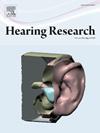Ear-specific neuroplasticity for sound localization in individuals with single-sided deafness
IF 2.5
2区 医学
Q1 AUDIOLOGY & SPEECH-LANGUAGE PATHOLOGY
引用次数: 0
Abstract
Studies on cortical plasticity in individuals with single-sided deafness (SSD) show increased activity in the auditory cortex ipsilateral to the hearing ear, impacting auditory localization and rehabilitation outcomes. However, the direct relationship between neuroplastic changes and binaural processing in SSD remains unclear, as does the specificity of plasticity to the affected ear. In this study, two groups of SSD patients (left [Lt] SSD, 17; right [Rt] SSD, 18) of postlingual onset and 13 normal-hearing controls (NC) underwent fMRI during an auditory localization task. The NC group was also treated with earplugs to simulate acute monaural hearing. We compared the cortical networks involved in auditory localization and conducted correlation analyses to identify neural activity associated with SSD duration and localization performance. The response laterality in the auditory cortex was analyzed and compared across groups. Results indicated that extended SSD modulates auditory cortical response in the right primary auditory cortex. The posterior superior temporal gyrus and cingulo-opercular network were linked to improved localization performance. Findings suggest that cortical attentional resources are crucial for auditory spatial behavior in SSD, especially when the left ear is impaired.
单侧耳聋个体声音定位的耳特异性神经可塑性
对单侧耳聋(SSD)患者皮质可塑性的研究表明,听力侧同侧的听觉皮层活动增加,影响听觉定位和康复结果。然而,SSD患者的神经可塑性变化与双耳加工之间的直接关系尚不清楚,可塑性对受病耳的特异性也不清楚。本研究中,两组SSD患者(左[Lt] SSD, 17;右[Rt] SSD, 18)和13名正常听力对照(NC)在听觉定位任务期间进行了fMRI检查。NC组用耳塞模拟急性单耳听力。我们比较了参与听觉定位的皮层网络,并进行了相关分析,以确定与SSD持续时间和定位性能相关的神经活动。分析并比较各组听觉皮层的反应偏侧性。结果表明,扩展SSD可调节右侧初级听觉皮层的听觉反应。后颞上回和扣带回-眼窝网络与定位性能的提高有关。研究结果表明,皮层注意力资源对SSD患者的听觉空间行为至关重要,尤其是当左耳受损时。
本文章由计算机程序翻译,如有差异,请以英文原文为准。
求助全文
约1分钟内获得全文
求助全文
来源期刊

Hearing Research
医学-耳鼻喉科学
CiteScore
5.30
自引率
14.30%
发文量
163
审稿时长
75 days
期刊介绍:
The aim of the journal is to provide a forum for papers concerned with basic peripheral and central auditory mechanisms. Emphasis is on experimental and clinical studies, but theoretical and methodological papers will also be considered. The journal publishes original research papers, review and mini- review articles, rapid communications, method/protocol and perspective articles.
Papers submitted should deal with auditory anatomy, physiology, psychophysics, imaging, modeling and behavioural studies in animals and humans, as well as hearing aids and cochlear implants. Papers dealing with the vestibular system are also considered for publication. Papers on comparative aspects of hearing and on effects of drugs and environmental contaminants on hearing function will also be considered. Clinical papers will be accepted when they contribute to the understanding of normal and pathological hearing functions.
 求助内容:
求助内容: 应助结果提醒方式:
应助结果提醒方式:


